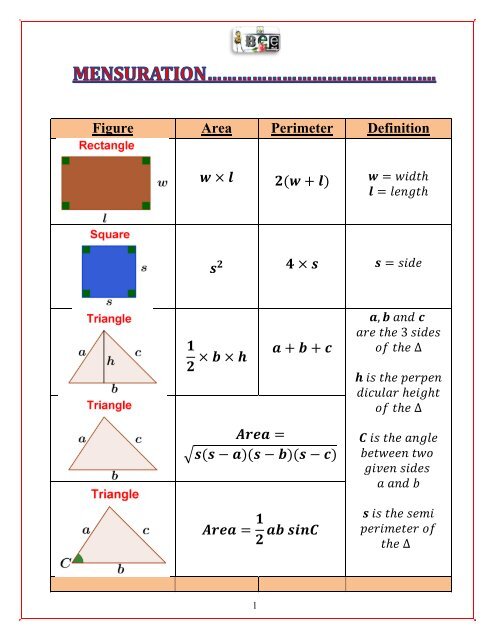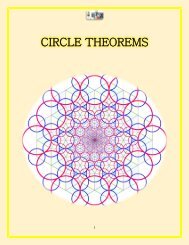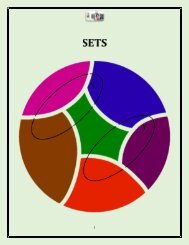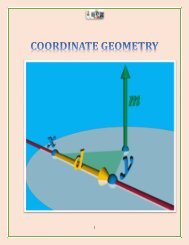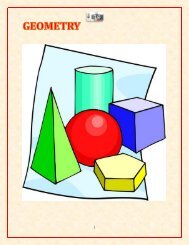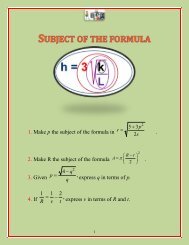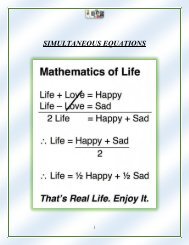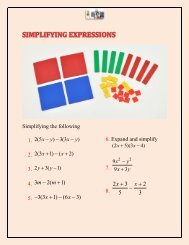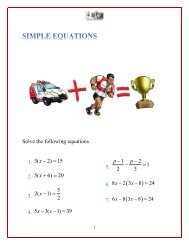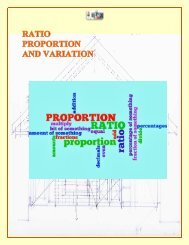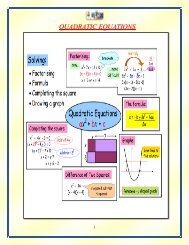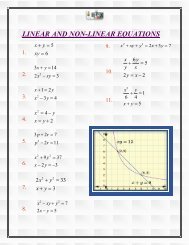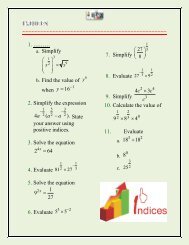Create successful ePaper yourself
Turn your PDF publications into a flip-book with our unique Google optimized e-Paper software.
Figure Area Perimeter Definition<br />
w × l 2(w + l) w = width<br />
l = length<br />
s 2 4 × s s = side<br />
1<br />
a<br />
× b × h<br />
2<br />
+ b + c<br />
a, b and c<br />
are the 3 sides<br />
of the ∆<br />
h is the perpen<br />
dicular height<br />
of the ∆<br />
Area =<br />
√s(s − a)(s − b)(s − c)<br />
Area = 1 ab sinC<br />
2<br />
C is the angle<br />
between two<br />
given sides<br />
a and b<br />
s is the semi<br />
perimeter of<br />
the ∆<br />
1
Figure Area Perimeter Definition<br />
π = 3.142 or<br />
22<br />
πr 2<br />
2πr<br />
7<br />
r = radius of<br />
circle<br />
1<br />
a<br />
(a + b)h<br />
2<br />
+ b + p<br />
+ q<br />
a, b are the<br />
parallel sides<br />
p, q are<br />
non − parallel<br />
h − height<br />
d 1 × d 2<br />
a + b + p<br />
+ q<br />
side a = side b<br />
side p = side q<br />
d 1 and d 2<br />
− diagonals<br />
Solid<br />
Surface<br />
Area<br />
Volume<br />
Definition<br />
2lw + 2lh<br />
+ 2wh<br />
l × w × h<br />
l = length<br />
w = width<br />
h = height<br />
2
Solid<br />
Surface<br />
Area<br />
Volume<br />
Definition<br />
6s 2 s 3 s = side<br />
2πr(r + h)<br />
πr 2 h<br />
π = 3.142 or<br />
22<br />
7<br />
r = radius of<br />
circle<br />
h = height<br />
- 1<br />
3 Ah<br />
A = Base area<br />
h = height<br />
1<br />
3 πr2 h<br />
π = 3.142 or<br />
22<br />
7<br />
r = radius of<br />
circle<br />
h = height<br />
4πr 2<br />
4<br />
3 πr3<br />
π = 3.142 or<br />
22<br />
7<br />
r = radius of<br />
circle<br />
3
1. The diagram below, not drawn to scale, shows a circle<br />
inscribed in a square (take π to be<br />
22<br />
7<br />
)<br />
a. Given that the radius of the circle is 9 cm.<br />
Calculate<br />
i. The circumference of the circle<br />
ii. The perimeter of the square<br />
b. Given that the circumference of the circle is<br />
30 cm, calculate<br />
i. The area of the circle<br />
ii. The area of the square<br />
iii. The area of the shaded region<br />
2. In the figure below, the arcs PS and QR are semicircles,<br />
each of radius 3.5cm, PQ = SR = 12 cm. Take π to be<br />
22<br />
7<br />
.<br />
4
Calculate<br />
i. The perimeter, in cm, of the figure PQRS<br />
ii. The area in cm 2 of the PQRS<br />
3. A piece of wire, formed into a circle, encloses an area of<br />
1386 cm 2 .<br />
i. Calculate the radius of the circle<br />
ii. Calculate the length of the wire used to form the<br />
circle.<br />
iii. The wire is then bent to form a square. Calculate, in<br />
cm 2 , the area of the square.<br />
4. Use<br />
<br />
22<br />
7<br />
to answer this question.<br />
The diagram above, not drawn to scale, represents a<br />
plot of land in the shape of a trapezium ABCE and a<br />
semicircle CDE.<br />
AE = 14m, BC = 19 m, and EC = 14m. AE is a<br />
perpendicular to CB.<br />
5
i. Calculate, in square metres, the total area of the plot<br />
of land.<br />
ii. Calculate to the nearest metre the distance around<br />
the entire plot of land.<br />
5. In the diagram, not drawn to scale, the<br />
two points F and G are the endpoints of the<br />
base of a triangular flower-bed PFG, in<br />
PF PG<br />
8 cm<br />
FGP<br />
75<br />
which<br />
. If<br />
,<br />
calculate the area of the flower-bed and the<br />
length of FG.<br />
6.<br />
The trapezium DEFG,<br />
not drawn to scale, DE<br />
= 10 cm, DG = 14 cm<br />
and GX = 8 cm. Angle<br />
EFX and DXF are right<br />
angles.<br />
Calculate<br />
i. the length of DX<br />
ii. the area of trapezium DEFG.<br />
6
7.<br />
In the diagram above, not drawn to scale, ST = 5 cm,<br />
TW = 9 cm and STW = 52°.<br />
Calculate<br />
i. the length of SW<br />
ii. the area of<br />
STW<br />
8. In a circle, Centre O, AB is a chord of length 12 cm.<br />
Given that<br />
figures, the area of the minor segment cut off by AB<br />
[take π = 3.14]<br />
BOA<br />
70. Calculate to three significant<br />
9. Because of the swampy ground, the path from A to B has<br />
to skirt the arc<br />
PQ of a circular<br />
pond, centre O<br />
and radius 14m.<br />
The distances<br />
from A and B to<br />
the nearest point<br />
on the pond are<br />
7
oth 36 m. the angle OAB = 30°<br />
Find in metres the total length of the path APQB, giving<br />
the answer correct to 2 significant figures.<br />
10. A chord PQ of a circle of radius 7 cm is 5 cm from O<br />
the centre of the circle.<br />
Calculate:<br />
a. The size of the angle subtended by the arc PQ at O.<br />
b. The length in cm of the arc PQ<br />
c. The area in cm 2 , of the minor sector OPQ.<br />
11. ………<br />
In the figure above, not drawn to scale, PS is an arc of<br />
a circle of radius 5 cm and Q is the centre of the circle ,<br />
RQ = 8 cm, PR = 7 cm.<br />
Calculate<br />
a. The size of angle Q<br />
b. The area of the shaded portion bounded by the arc<br />
PS and the line segment PR and RS. (use π=3.14)<br />
8
12. …..<br />
The figure OAB, not<br />
drawn to scale,<br />
represents a flower bed<br />
in the shape of a sector of<br />
a circle centre O, radius 8<br />
m the triangular region<br />
OAB is planted in roses<br />
and the segment bounded<br />
by the chord AB and the<br />
arc AB is planted in<br />
marigolds.<br />
Given that the angle AOB = 40°, calculate the area of<br />
the segment assigned to the marigolds.<br />
[Take π = 3.14]<br />
13. The diagram, not drawn to scale, shows a circle with<br />
centre O and two radii, OJ and<br />
OK. LK is a tangent to the<br />
circle at K. OJL is a sight line;<br />
angle KOJ = 3 and OJ = 7 cm.<br />
i. Show that KL = OK tan<br />
30°and hence or<br />
otherwise calculate the<br />
area , in cm 2 , of triangle<br />
KOL<br />
ii. Calculate the area, in cm 2 , of<br />
a. the minor sector KOJ<br />
b. the triangle KOL<br />
c.<br />
9
14. The diagram, not drawn to scale,<br />
shows a circle with centre Y,<br />
containing an Equilateral triangle<br />
XYZ. Given that the diameter of<br />
the circle is 42 cm, calculate<br />
i. the area of the sector YXPZ<br />
ii. the area of the shaded<br />
portion of the circle<br />
15. The diagram, not drawn to scale, shows a circle of<br />
radius 10 cm, O is the centre of the circle. J, K, and L are<br />
points on the circumference of the circle. Angle JOK =<br />
150°. Take π = 3.14.<br />
i. Calculate the length, in<br />
cm, of the minor arc JK.<br />
ii. Show that the area of<br />
the minor sector OJK is<br />
10<br />
125<br />
cm<br />
2<br />
3<br />
iii. If the area of the<br />
triangle LOK is 43.3cm 2 ,<br />
calculate, in degrees, the size of angle LOK.<br />
16. The diagram, not drawn to<br />
scale, shows a circle centre<br />
O, radius 15 cm. the length<br />
of the minor arc is 9 cm and<br />
LN is a tangent to the circle.<br />
OMN is a straight line.<br />
i. Calculate, in radians the<br />
size of angle MOL.<br />
ii. Calculate the area of the minor sector OML<br />
.
iii. Calculate the area of the shaded region.<br />
17. ……..<br />
[Take π = 3.14]<br />
In the diagram above, not drawn<br />
to scale, MPNO is the sector of a<br />
circle, with centre O and radius<br />
14 cm. Angle MON is 72°.<br />
Calculate, to 1 decimal place the<br />
area of<br />
i. Triangle OMN<br />
ii. The shaded region<br />
bounded by the chord MN and<br />
the arc MPN.<br />
18. A rectangular wooden beam of length 5 metres has a<br />
cross section of 20 cm by 15 cm. the wood has a density<br />
of 600 kg per m 3 .<br />
a. Calculate the volume of the beam in cubic metres<br />
b. Express the answer for ‘a’ in standard form.<br />
c. Calculate the mass of the beam in kg.<br />
19. A cylindrical object of height 21 cm has an outer<br />
diameter of 28 cm and an inner diameter of 24 cm. The<br />
material of which it is made has a density of 6g per cm 3 .<br />
Calculate, to the nearest kg, the mass of the object<br />
11
20. A rectangular steel pyramid of height 6 cm and base<br />
dimensions 11 cm by 16 cm, is melted down and rolled<br />
into a cylinder of height 7 cm.<br />
Calculate<br />
i. the radius of the cylinder in cm.<br />
ii. the mass of the cylinder in kg, if the density of the steel<br />
is 5g per cm 3 .<br />
(Note: Volume of a pyramid =<br />
2<br />
Volume of cylinder = r h<br />
21. …….<br />
1<br />
3 Ah,<br />
, take π =<br />
22<br />
7<br />
)<br />
The figure ABCDEF above, not drawn to scale,<br />
represents a wedge with measurements as shown. BC is<br />
perpendicular to the plane FEDC.<br />
Calculate<br />
i. the length in cm of BD<br />
ii. the surface area, in cm 2 , of the wedge<br />
iii. the volume in cm 3 , of the wedge<br />
iv. the size of angle BDC.<br />
12
22. To answer this question use π =<br />
13<br />
22<br />
7<br />
and<br />
V<br />
r<br />
2<br />
, where<br />
V = volume, r = radius and h = height of the cylinder.<br />
a. The internal dimensions of a sauce pan shaped like<br />
a cylinder height 25 cm and diameter 42 cm.<br />
Calculate to the nearest whole number,<br />
i. the area, in cm 2 , of the bottom of the saucepan<br />
ii. the largest volume of liquid, in cm 3 , which the<br />
saucepan can hold.<br />
b. The saucepan is filled with water which is then<br />
poured into a empty cylindrical pot of radius 28 cm.<br />
Calculate the height of the water level above the<br />
bottom of the pot.<br />
23. A closed cylinder has a base of diameter 28 cm and a<br />
vertical height of 28 cm. Take<br />
<br />
22<br />
i. the area, in cm 2 , of the base<br />
ii. the volume, in cm 3 , of the cylinder<br />
iii. the total surface area of the cylinder.<br />
7<br />
. Calculate<br />
24. The diagram, not drawn to scale, represents a right<br />
open ended paper cone. The<br />
slant height VX is 14cm, the<br />
base diameter XY is 21 cm and<br />
VO is the height of the cone.<br />
[take<br />
22<br />
7<br />
]<br />
i. Calculate, in cm, the<br />
circumference of the base of the<br />
cone.<br />
ii. Find the height of the cone.
iii. Calculate the volume in cm 3 of the cone.<br />
25. ……..<br />
a. A rectangular tank is 8 m high and its base is 4 m<br />
long and 3 m wide. The tank is filled with water.<br />
Calculate;<br />
i. the area, in cm 2 , of the base of the tank and write<br />
your answer in standard form.<br />
ii. the capacity, in litres, of the tank. Use 1000cm 3 =<br />
1 litre.<br />
b. All the water from the rectangular tank is pumped<br />
into a cylindrical tank to a height of 8 m. Calculate<br />
to, 3 significant figures, the radius of the base of the<br />
cylindrical tank.<br />
26. …..<br />
i. A cylindrical metal drum of height 125 cm, has a<br />
capacity of 700 litres. Calculate the diameter of the<br />
drum.<br />
ii. Oil is poured into the drum for 1 hour 15 minutes at<br />
a rate of x litres per minute until it just begin to<br />
overflow. Calculate the value of x.<br />
iii. [1000 cm 3 = 1 litre]<br />
14
27.<br />
A circular drain pipe, shown in the diagram above, not<br />
drawn to scale, is 1 metre long, with outer and inner<br />
radii of 21 cm and 14 cm respectively.<br />
i. Draw a cross-sectional view of the drainpipe,<br />
showing the measurement of the inner and outer<br />
radii.<br />
Calculate;<br />
ii. the area, in cm 2 , of the cross section of the drain<br />
pipe.<br />
iii. the amount, in cm 3 , of the material required to<br />
construct the drain pipe.<br />
iv. The capacity, in litres of the hallow space of the<br />
drain pipe.<br />
v. The volume, in litres , of water passing through the<br />
pipe in 1 minute if the water flows through the pipe<br />
at a speed of 1 metre per second<br />
28. [Take 3.142 ]<br />
[curved surface area<br />
of a cylinder = 2 rh ]<br />
The diagram, not<br />
drawn to scale,<br />
represents an open<br />
metal container. The<br />
cross-section of the<br />
container is a semi-<br />
<br />
15
circle of diameter 1.5m the length of the container is<br />
3.5m.<br />
a. Write down the radius of the cross section of the<br />
container.<br />
b. Calculate in m 2 , to two decimal places<br />
i. The area of the cross-section of the container<br />
ii. The outer curved surface area of the container<br />
iii. The total outer area of the container<br />
c. Calculate the capacity, in m 3 , of the container<br />
d. Water is poured into the container at a rate of 30<br />
litres per minute. Calculate the length of time in<br />
minutes it would take to just fill the container.<br />
[Note: 1m 3 =1000l]<br />
29. ……..<br />
The diagram above, not drawn to scale, shows a<br />
wooden prism of length 25 cm. the cross section ABCD<br />
is a trapezium with AB parallel to DC, BAD<br />
90 ,<br />
AB = 12 cm, BC = 5 cm,<br />
and AD = 3 cm.<br />
Calculate<br />
i. The area, in cm 2 , of the cross-section, ABCD<br />
ii. The volume, in cm 3 , of the prism<br />
iii. The total surface area, in cm 2 , of the prism.<br />
CD 8 cm<br />
16
30. The triangular prism, shown<br />
the diagram below, not drawn<br />
to scale, is 18 cm long.<br />
Triangle GHI has a height of<br />
3 cm, HI = 8 cm and GH = GI.<br />
i. The area of triangle<br />
GHI<br />
ii. The volume of the triangular prism<br />
iii. The length of GI<br />
iv. The total surface area of the prism.<br />
31. The diagram, not drawn to scale, represents a plot of<br />
land ADCBE in the shape of a square of sides 21 m with<br />
a semicircle at one end.<br />
i. Calculate, the<br />
perimeter of the plot.<br />
ii. WXYZ is a<br />
rectangular flower bed of<br />
length 15 m and width 12 m.<br />
Calculate the area of the<br />
shaded section.<br />
32. The diagram, not drawn to<br />
scale, shows ABCDE, a vertical<br />
cross-section of a container with<br />
17
ED being the top edge. DC and EF are vertical edges.<br />
BC and AF are arcs of a circle of radius 7 cm, and<br />
AB||ED.<br />
ED = 30cm; AB = 16 cm; EF = DC = 9 cm<br />
i. Taking<br />
<br />
22<br />
7<br />
, show that the area of ABCDEF is<br />
459 cm 2 .<br />
ii. If the container is 40 cm long and has a uniformed<br />
cross-section, calculate to the nearest the volume of<br />
the container.<br />
33. …….<br />
i. ABCDEFG is a sketch of the net of a pyramid on a<br />
square base BDFH of side 3 cm with slant edges of<br />
length 5 cm.<br />
a. Draw an accurate full size diagram of the net.<br />
b. Measure and write down the length of EA.<br />
ii. The net is assembled as a pyramid with apex V and<br />
base BDFH.<br />
18
a. Sketch the cross section VDH of the pyramid<br />
indicating clearly on your sketch the lengths of<br />
VD and DH.<br />
b. By calculation, determine VX the height of the<br />
pyramid.<br />
[X is the centre of the base]<br />
34. VMNPQ is a pyramid on a square base MNPQ of side<br />
40 cm.<br />
i. Draw a diagram to represent the pyramid. Clearly<br />
label the vertices.<br />
ii. Draw a plan of the pyramid, viewed from above.<br />
State the scale used.<br />
iii. The height of the pyramid is 20 cm. Show that the<br />
length of the sloping edge, VM, is 20 3 cm .<br />
35. Notes for this question<br />
Take<br />
<br />
22<br />
7<br />
Volume of a cone =<br />
1 2<br />
3 r h<br />
The diagram above, not drawn to scale, shows a major<br />
sector, AOB, of a circle of radius 6 cm. it represents the<br />
net of a cone.<br />
a. Show by calculation that the radius of the base of<br />
the cone is 22 cm.<br />
b. Calculate:<br />
i. The radius of the base of the cone<br />
19
ii. The height of the cone giving your answer<br />
correct to one decimal place<br />
c. Calculate to two significant figures the volume, in<br />
litres, the cone holds when filled<br />
36. The diagram VXY, not drawn to<br />
scale, represents a right openended<br />
paper cone. The slant height<br />
VX is 14 cm, the base diameter<br />
XY is 21 cm, and VO is the height<br />
of the cone<br />
22<br />
[Take = ]<br />
7<br />
The cone is cut along a straight<br />
line drawn from Y to V. the paper<br />
is flattened out to form a plane<br />
figure.<br />
i. Draw a diagram of the plane figure, showing the<br />
position of V.<br />
ii. Write the length of each side on your diagram.<br />
iii. Calculate the size, in degrees, of the angle at V<br />
37. A piece of wire is bent in the form of a circle and it<br />
encloses an area of 154 cm 2 .<br />
Calculate<br />
i. the radius of the circle<br />
ii. the circumference of the circle<br />
38. The figure, not drawn<br />
to scale, shows the<br />
cross-section ABCD<br />
of a swimming pool,<br />
12 m long. AB is the<br />
horizontal top edge,<br />
20
AD shows the depth at the shallow end and BC the depth<br />
at the deep end.<br />
a. Calculate giving the answer correct to 1decimal<br />
place,<br />
i. α, the angle that DC makes with the<br />
horizontal<br />
ii. the length of the sloping edge<br />
b. Given that the pool is 5 m wide, calculate the total<br />
surface of the inner walls and the bottom of the pool<br />
39. ABC and D lie in a circle, centre<br />
O, of radius 14 cm.<br />
AO is a diameter of a circle<br />
through A, P, O, and Q<br />
a. Write down the radius of the<br />
circle APOQ<br />
b. Take<br />
to be<br />
22<br />
7<br />
40. A closed storage<br />
container consists of<br />
a cuboid<br />
ABDEPQST, to<br />
which a quadrant of<br />
a cylinder,<br />
BCDQRS, is<br />
attached as shown<br />
in the diagram.<br />
, calculate<br />
i. the area of the<br />
shaded region<br />
ii. the total length of the boundary of the<br />
shaded region<br />
21
AE = 20 cm, ED = 30 cm, DC = 20 cm, and CR = 70 cm.<br />
Taking π to be 3.142, and giving each answer to 3<br />
significant figures, calculate<br />
a. the area of the face ABCDE<br />
b. the volume of the container<br />
22


